

A Visual Timeline of the Future Based on Famous Fiction. By Maria Popova Proof that in the year 802701, the world will still exist.
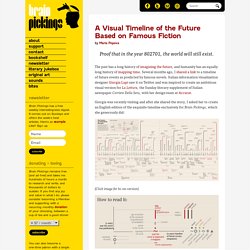
The past has a long history of imagining the future, and humanity has an equally long history of mapping time. Several months ago, I shared a link to a timeline of future events as predicted by famous novels. Italian information visualization designer Giorgia Lupi saw it on Twitter and was inspired to create an ambitious visual version for La Lettura, the Sunday literary supplement of Italian newspaper Corriere Della Sera, with her design team at Accurat. Giorgia was recently visiting and after she shared the story, I asked her to create an English edition of the exquisite timeline exclusively for Brain Pickings, which she generously did: (Click image for hi-res version)
Tomorrow’s world: A guide to the next 150 years. Tomorrow's world: A guide to the next 150 years. Lifemapper Web App. <div class="noscript-warning"><div class="noscript-content"> The Lifemapper Test Drive requires javascript to be turned on in your browser.
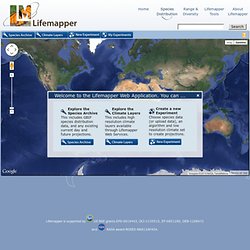
Please make that change in your browser preferences before continuing. </div></div> Imagery ©2014 NASA, TerraMetrics Terms of Use Map Satellite Lifemapper Species Maps and Models The Lifemapper Species Maps and Model (LmSDM) web application is meant to be an introduction to species distribution modeling. PDF/Timeline of Emerging Science and Technology.pdf. The Life Cycle Of Ideas. Every scientific idea has its day.
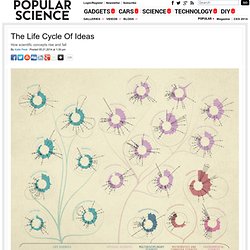
Theories are born and experiments are designed; results are put to the test, then disproved or accepted as canon. As scientists discuss an idea, they cite the paper that proposed it in their own work. 'Edifice Sequence' from Saul Bass' Why Man Creates. Take A Journey To The Year 2020 - 2025 Future Technology. Welcome to the 2030s (Future Timeline Events 2030-2039) Welcome to the 2020s (Future Timeline Events 2020-2029) All The Times Science Fiction Became Science Fact In One Chart. Www.jfs.tku.edu.tw/13-4/AE02. 011rowecomment.pdf. UK interest rates since 1694. 8 Surprising Historical Facts That Will Change Your Concept Of Time Forever.
You probably should know these things didn't happen anywhere near when you thought they did...

Not everyone can be a world history master, especially when we tend to learn about it in specifically segmented classes like "European History" or "American Revolutionary History. " Maybe you have an exceptional grasp on the global historical timeline. Www.crispian.net/CrispiansScienceMap.html. Brands: Time To Meet The Millennial Generation. Cartographies of Time: A Visual History of the Timeline. By Maria Popova A chronology of one of our most inescapable metaphors, or what Macbeth has to do with Galileo.

I was recently asked to select my all-time favorite books for the lovely Ideal Bookshelf project by The Paris Review’s Thessaly la Force and artist Jane Mount. Despite the near-impossible task of shrinking my boundless bibliophilia to a modest list of dozen or so titles, I was eventually able to do it, and the selection included Cartographies of Time: A History of the Timeline (public library | IndieBound) by Daniel Rosenberg and Anthony Grafton — among both my 7 favorite books on maps and my 7 favorite books on time, this lavish collection of illustrated timelines traces the history of graphic representations of time in Europe and the United States from 1450 to the present, featuring everything from medieval manuscripts to websites to a chronological board game developed by Mark Twain.
Terra Incognita: maps that shaped the world – in pictures. Mapping Our World: Terra Incognita to Australia is an exhibition that brings to Australia maps never before seen in the country.
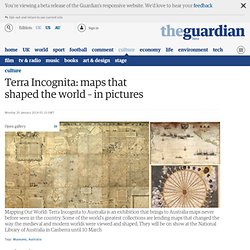
Some of the world's greatest collections are lending maps that changed the way the medieval and modern worlds were viewed and shaped. They will be on show at the National Library of Australia in Canberra until 10 March. Future Timeline. How the world will end, in one chart. We all know that in the distant future, the year 2000, robotic beings will rule the world.

But what about the future after that? Well, that’s where the above timeline from the BBC comes in. 5.4 billion years from now, for instance, the Sun will run out of fuel. 110 trillion years from now, all stars will run out of fuel. 100 quintillion years from now, the Earth — if it hasn’t been destroyed already — will have decayed enough to be swallowed up by the Sun (in whatever diminished state it takes at that point). London in 1927 & 2013. Future Rainfall Predictions Climate Change. 101 Sci-Fi Adventures. Image from John Hilgart’s 4CP archive Recently, I compiled a list of two hundred of my favorite adventures published before the Eighties (1984–93).
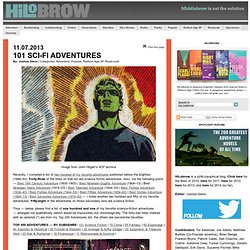
Forty-three of the titles on that list are science fiction adventures. Also, via the following posts — Best 19th Century Adventure (1805–1903) | Best Nineteen-Oughts Adventure (1904–13) | Best Nineteen-Teens Adventure (1914–23) | Best Twenties Adventure (1924–33) | Best Thirties Adventure (1934–43) | Best Forties Adventure (1944–53) | Best Fifties Adventure (1954–63) | Best Sixties Adventure (1964–73) | Best Seventies Adventure (1974–83) — I listed another two hundred and fifty of my favorite adventures. Fifty-eight of the adventures on those secondary lists are science fiction. The Top 101 Science Fiction Adventures. I was thinking about that, but... what about The Lost World doesn't qualify as science fiction, given the time in which it was written?
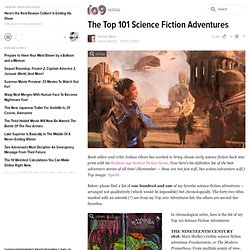
Paleontology and biology (whether you're talking about studying the remains of dinosaurs or living dinosaurs) are sciences, and exploration (including the discovery of new species, or the discovery of still-living previously-thought-extinct species) is about science. It's still speculative fiction with a scientific premise (even if that premise has a thick gloss of pulp adventure), even though we now regard it as fantastical. But it's a reminder that "science" encompasses more than just space and lasers. While paleontology and biology are both sciences, discovering dinosaurs in a jungle is fantasy. The difference lies in that they were not created through science nor was anything else.
Having a critter, saying that its part of biology, and therefore science doesn't fly. Atul Gawande: How Do Good Ideas Spread? Why do some innovations spread so swiftly and others so slowly?

Consider the very different trajectories of surgical anesthesia and antiseptics, both of which were discovered in the nineteenth century. The first public demonstration of anesthesia was in 1846. The Boston surgeon Henry Jacob Bigelow was approached by a local dentist named William Morton, who insisted that he had found a gas that could render patients insensible to the pain of surgery.
That was a dramatic claim. In those days, even a minor tooth extraction was excruciating. On October 16, 1846, at Massachusetts General Hospital, Morton administered his gas through an inhaler in the mouth of a young man undergoing the excision of a tumor in his jaw. Four weeks later, on November 18th, Bigelow published his report on the discovery of “insensibility produced by inhalation” in the Boston Medical and Surgical Journal.
Atul Gawande: How Do Good Ideas Spread? Gartner's 2013 Emerging Technologies hype cycle focuses on humans and machines. The 2013 edition of Gartner's long-running Hype Cycle for Emerging Technologies focuses on "the evolving relationship between humans and machines … due to the increased hype around smart machines, cognitive computing and the Internet of Things. " Gartner fellow Jackie Fenn, who came up with the hype cycle idea in 1995, says "there are actually three main trends at work. These are augmenting humans with technology — for example, an employee with a wearable computing device; machines replacing humans — for example, a cognitive virtual assistant acting as an automated customer representative; and humans and machines working alongside each other — for example, a mobile robot working with a warehouse employee to move many boxes.
" Fenn's collaborator Hung LeHong says these trends have been made possible because machines are becoming better at understanding humans and humans are becoming better at understanding machines. Perspectives on International Security The Manhattan Project. A poster by Harvard scientists shows 4.6 billion years of evolutionary history. Packing the Earth’s 4.6-billion-year history into a two-foot-by-three poster—roughly three-quarters of a billion years per square foot—is no easy task. Yet scientists from Harvard and the Howard Hughes Medical Institute (HHMI) in Chevy Chase, Maryland, have teamed up to do just that with “Earth Evolution: The Intersection of Geology and Biology”—a graphic display (opposite) of how geological and biological processes have dynamically shaped and molded the world we inhabit.
Classic visualizations of life on Earth typically pick up the tale 540 million years ago, when oxygen, land plants, and certain marine invertebrates became abundant. “Earth Evolution” tells a much longer and more complex story, stretching back to the earliest evidence of life. The Histomap of Evolution. The 1931 Histomap: The entire history of the world distilled into a single map/chart. The Vault is Slate's history blog. Like us on Facebook, follow us on Twitter @slatevault, and find us on Tumblr. Find out more about what this space is all about here. This “Histomap,” created by John B. The Welikia Project » Overview. Overview – the Welikia Project Ever wondered what New York looked like before it was a city? Welcome to Welikia After a decade of research (1999 – 2009), the Mannahatta Project at the Wildlife Conservation Society un-covered the original ecology of Manhattan, one of New York City’s five boroughs.
The Welikia Project (2010 – 2013) goes beyond Mannahatta to encompass the entire city, discover its original ecology and compare it what we have today. How Much Is Left? The Limits of Earth's Resources, Made Interactive. Imagining the Internet. The Imagining the Internet Center's mission is to explore and provide insights into emerging network innovations, global development, dynamics, diffusion and governance. Its research holds a mirror to humanity's use of communications technologies, informs policy development, exposes potential futures and provides a historic record. It works to illuminate issues in order to serve the greater good, making its work public, free and open. The center is a network of faculty, students, staff, alumni, advisers and friends working to identify, explore and engage with the challenges and opportunities of evolving communications forms and issues.
They investigate the tangible and potential pros and cons of new-media channels through active research. Among the spectrum of issues addressed are power, politics, privacy, property, augmented and virtual reality, control and the rapid changes spurred by accelerating technology. Elon University is ranked #2 among Southern universities by U.S. Envisioning-technology-2011-03-07.png (2199×2199) ZAPADAY.